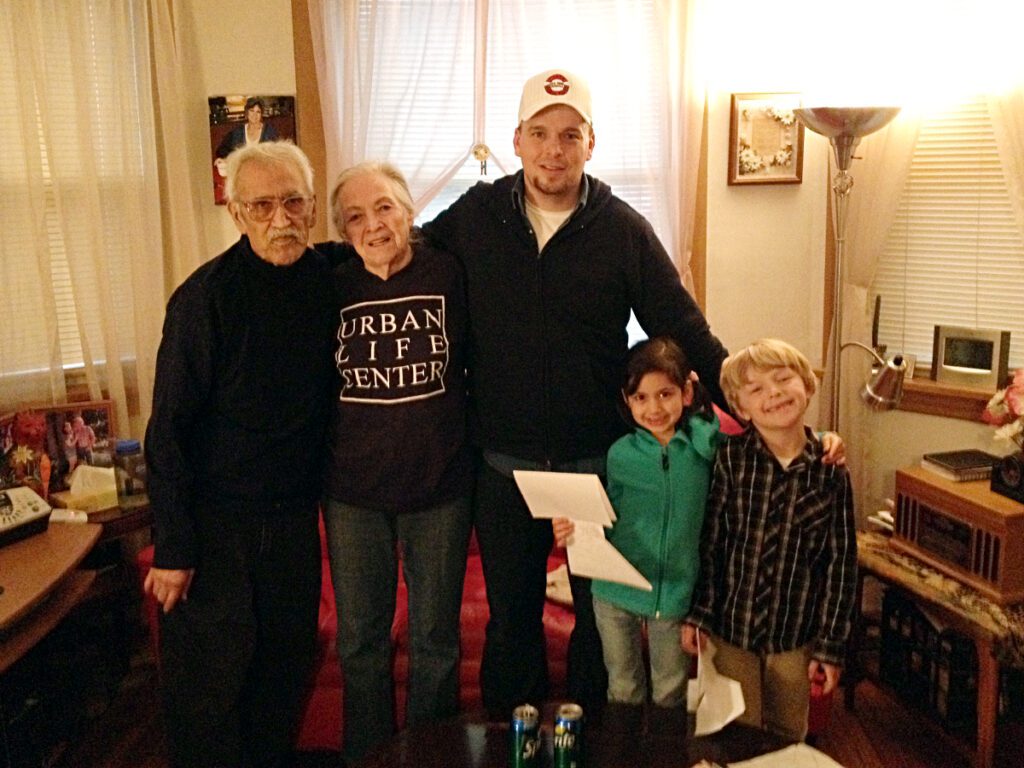
Jose Guerrero, a muralist, printmaker, educator, and revolutionary from Chicago, died on Wednesday. His beloved wife, Margaret, e-mailed to tell me the following day. Jose had been fighting cancer for a couple years now. I took my family to see him back in Easter. I’m sad today, because I miss my friend.
Jose is another fallen fighter and unsung saint. It is our duty to lift up fallen fighters and unsung saints. Jose Guerrero. Presente.
Jose, who was a disciple of the revolutionary Mexican art tradition – the tradition of Kahlo, Rivera, Siqueiros, and Orozco – gave me a perspective on art that will guide me for the rest of my days. Walking around Pilsen with him, encountering the murals and mosaics there, was the first time I ever really truly connected with visual art and culture – the first time it made profound sense to me. I was 22 years old, but an infant in my political consciousness. Jose was one of those first people to light the spark in me.
He taught me that all art and literature – as all things made by human beings – is political. All things concerning human beings has a political dimension. All things we need to survive, and all the ways we attempt to articulate to other human beings our understanding of the world – all of this is political. The sidewalk is political. The air we breathe is political.
Even if you hold the conviction that not all art is political – that there is such a thing as “art-for-the-sake-of-art,” that view in itself is a political position with consequences, whether or not you understand it as such. To be the rugged individualist as artist – the pure and timeless artist – does not negate the political nature of your art at the moment other human beings behold your work. And, after all, no one is a “self-made” artist. You exist within a society at a given historical moment. Jose’s art lesson led me to also understand that all things human are economic, including art. No pictures are painted out of thin air. Somebody paid for that abstract public art downtown – and chose not to fund other forms of expression and points of view. It is no surprise I learned the story of Diego Rivera and John D. Rockefeller, Jr from Jose.
Jose spent years working for the Parks Department. I know he spent years as a migrant laborer. Originating from around San Antonio, TX, he ended up in Chicago working in a factory. He was especially connected to the struggles of the community in the Pilsen neighborhood, but he also resided up in Humboldt Park, and did work with labor unions over the years. His most important contribution was, I believe, to be a teacher. He is among the most important teachers I’ve had the honor of learning from.
Jose was a working class intellectual – the best kind of intellectual. Working class intellectuals do not have the luxury to separate themselves from the world. Their knowledge does not come cheap. They have to work to live, and still manage to follow a commitment and calling beyond their own survival, even if that means you’ve been picking up garbage all day. If you approached the world the way Jose did, you would understand that race and class oppression are not abstract notions to be debated nor can they be separated. The battles in Pilsen over gentrification, low-wage jobs, environmental racism, police violence, attacks on immigrants – these were real life and death matters for which artists like Jose tried to provide clear understanding through art.
[aesop_image img=”https://kairoscenter.org/wp-content/uploads/2015/10/Jose-and-Margaret.jpg” align=”center” lightbox=”on” caption=”At home with Jose and Margaret Guerrero. John Wessel-McCoy, Indi Barnes, Myles Wessel-McCoy.” captionposition=”left”]
I will miss picking up six packs of Tecate and shooting the shit with him at his studio on 18th St every chance I got passing through Chicago. I will miss eating enchiladas suizas with Margaret and Jose at Nuevo Leon. I will miss witnessing the tenderness between these two gentle and funny people – Margaret, the Tennessean, and Jose, the Tejano. I will never forget when my three year old son, after having spent time with Jose and Margaret, was convinced that 1. Jose and Margaret were another set of grandparents he had not yet met; and 2. held on to the fascination that the old Czech theater out of which Jose operated was indeed haunted. Jose had told him so.
For a while I ran away from it, but the truth is I am working class white guy, a redneck kid from downstate Illinois – that’s right, I said redneck. Jose related to that side of me. We both liked Waylon Jennings and Hank Williams. He turned me on to Freddy Fender and Isidro Lopez’s Hank Williams tribute album, Cantan Country, and the song, “Redneck Meskin’ Boy” by Little Joe y la Familia. If your consciousness leads you to the left as a working class white person, you tend to follow the lead of self-described privileged and guilt-ridden whites who tell you to be an “ally.” Jose didn’t want me to be an ally. He wanted me to be a brother in the revolution. That never gives me a pass to deny racism or not take responsibilities for my own actions. In fact, Jose expected more out of me than to be an ally.
My commitment as a revolutionary has a lot to do with knowing people like Jose – people who care about something more than just themselves. People like Jose see this world is beautiful and that we have to fight for that beauty to be shared by all, and that all people deserve to live lives that are beautiful and decent.
Here’s a link to a video another artist made recently. He’s featured up front.
God bless you, Jose. Presente.